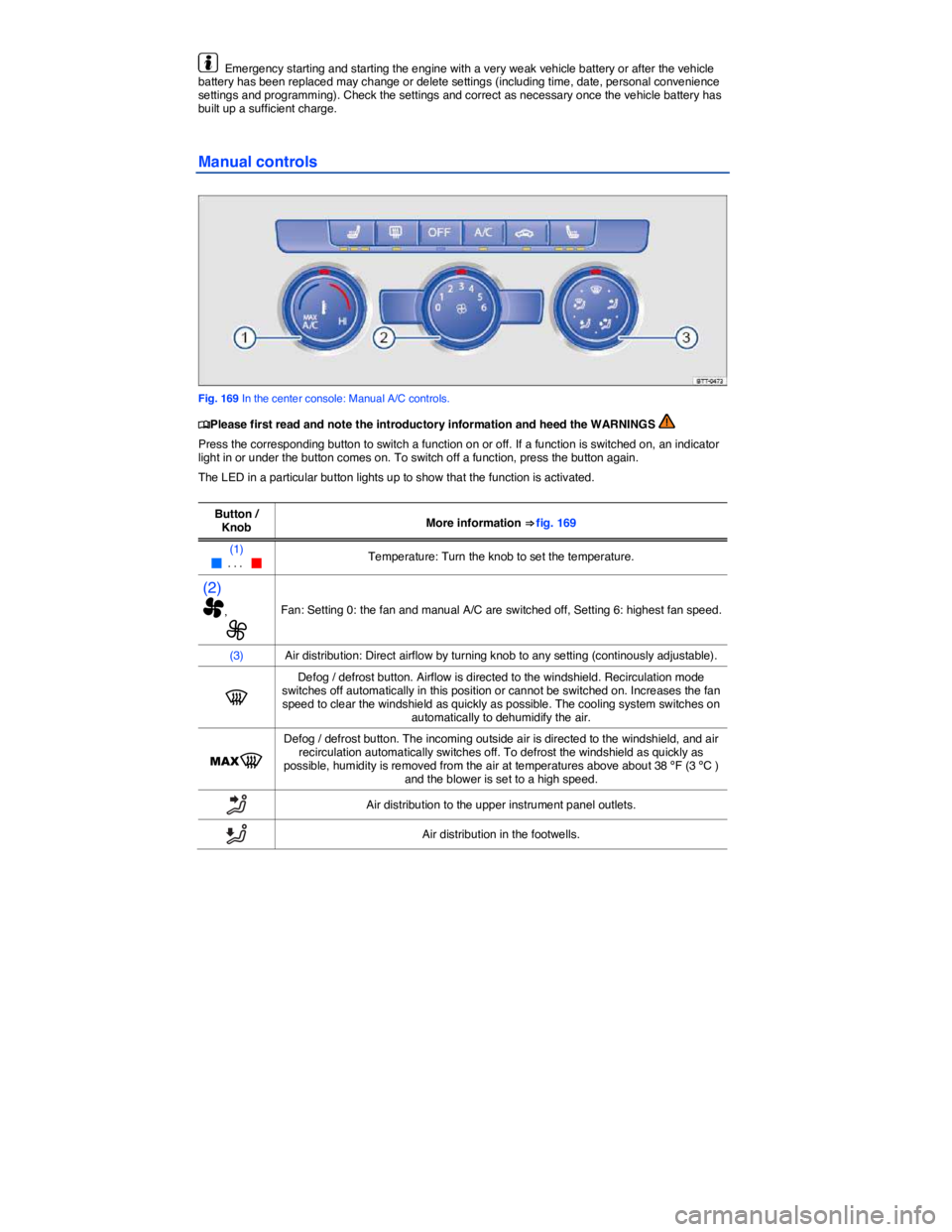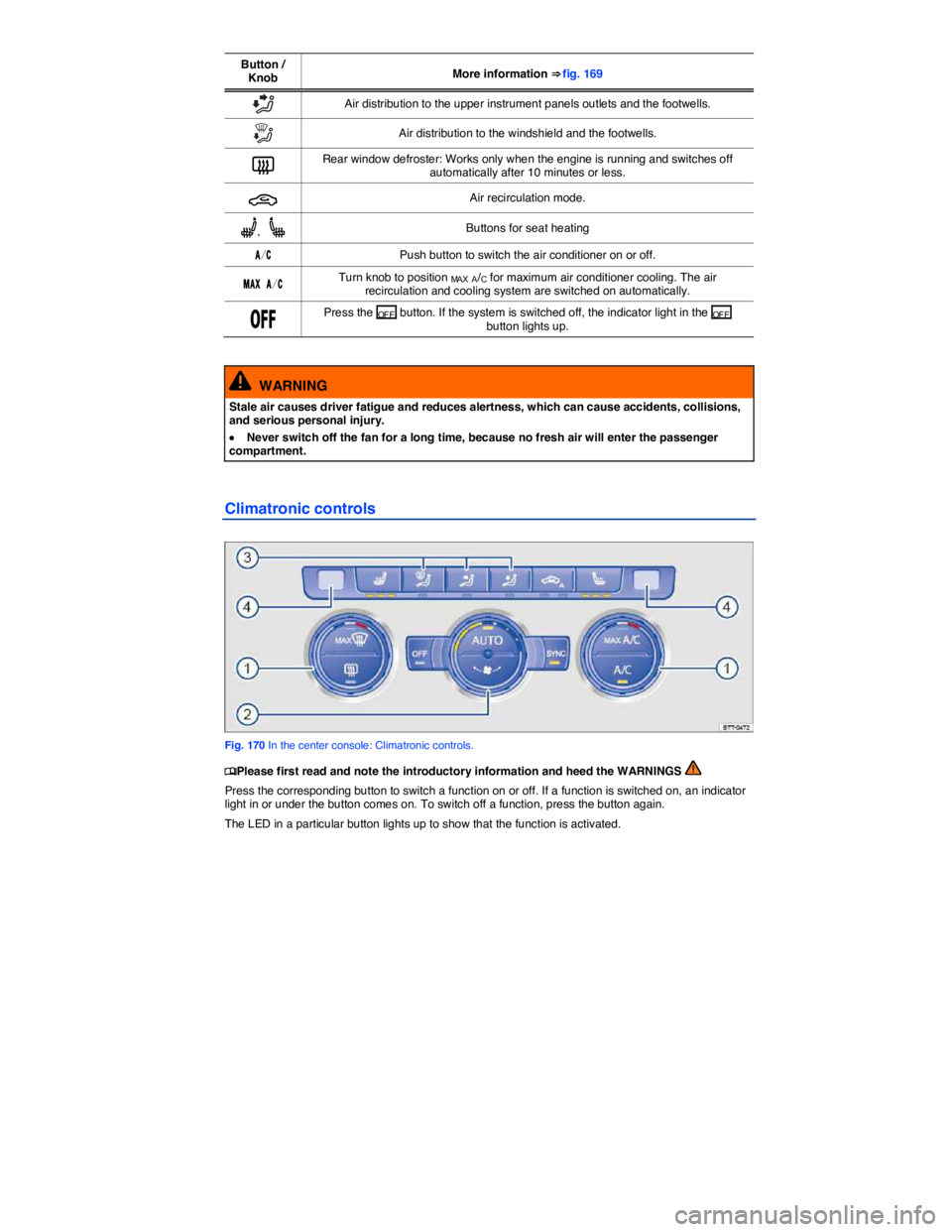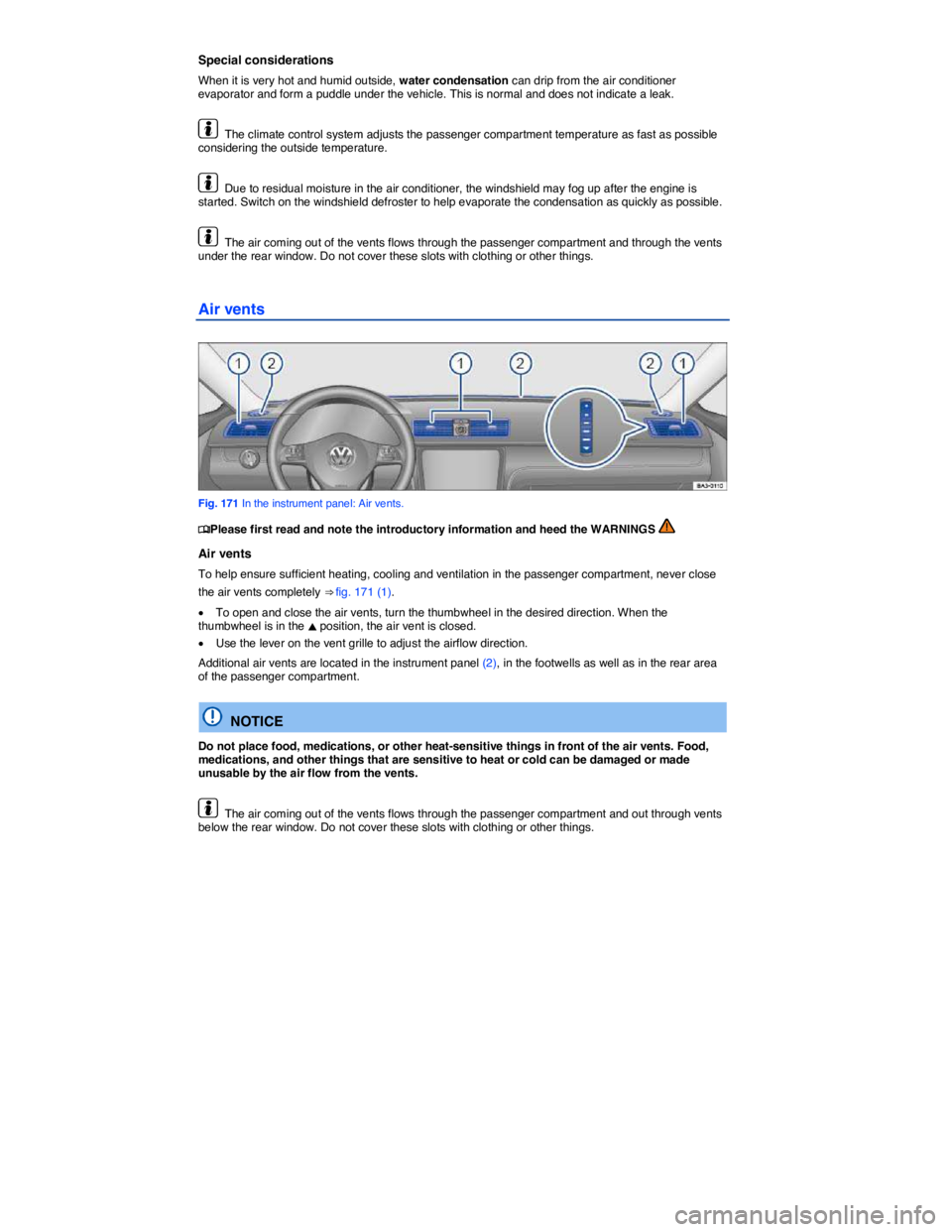2007 VOLKSWAGEN PASSAT engine
[x] Cancel search: enginePage 239 of 392

speed fluctuations caused by taking your foot off the accelerator. Active braking and accelerating is then not necessarily required.
Calm and smooth driving
Consistency is more important than speed. The more smoothly you drive, the less fuel the vehicle consumes.
When driving on the highway or freeway, a constant, moderate speed is more efficient and economical than constantly accelerating and braking. Usually you can reach your destination just as quickly by driving at a moderate, but steady speed.
The cruise control system can assist in maintaining a uniform driving style.
Moderate use of extra electrical loads
Comfort inside the vehicle is nice and important, but it is important to use them in an environmentally conscious manner.
Some devices can increase fuel consumption when activated (examples):
�x Climate control system (air conditioner): If the climate control system has to produce starkly contrasting temperatures, it requires a large amount of energy, which is generated by the engine. The temperature in the vehicle should therefore not be extremely different from that of the outside temperature. It may be helpful to ventilate the vehicle before driving and then to drive a short distance with the windows open. After that, switch on the air conditioner with the windows closed. Keep the windows closed when driving at high speeds. Open windows increase fuel consumption.
�x Switch off seat heating once it has served its purpose.
�x Switch off the rear window defroster as soon as the windows are free of fog and ice.
Additional factors that increase fuel consumption (examples):
�x Malfunctioning engine control.
�x Driving in the mountains.
�x Towing a trailer.
NOTICE
Never let the vehicle coast or roll down a hill in Neutral (N), especially when the engine is not running. The transmission will not be lubricated and will be damaged.
Page 241 of 392

Adjust the tire pressure
The proper tire pressure helps reduce rolling resistance as well as fuel consumption.
When purchasing new tires, always make sure that the tires are optimized for lower rolling resistance.
Use low viscosity engine oil
Fully “synthetic,” low viscosity engine oils that expressly comply with Volkswagen oil quality standards reduce fuel consumption. Low viscosity engine oils reduce the frictional resistance on the engine and are distributed more evenly and quickly, particularly when cold-starting the engine. The effect is particularly apparent in vehicles that frequently travel short distances.
Always ensure the right engine oil level is maintained and keep to the scheduled service intervals (engine oil changes).
Make sure the engine oil that you purchase expressly complies with Volkswagen oil quality standards and is the oil approved by Volkswagen for your vehicle.
Avoid unnecessary weight
The lighter the vehicle, the more economical and eco-friendly it will be. For example, an extra 220 lbs (100 kg) of weight increases fuel consumption by up to 1 pint per 60 miles (0.3 l/100 km).
Remove all unnecessary items and unnecessary dead weight from the vehicle.
Remove unnecessary aftermarket components
The more aerodynamic the vehicle, the less fuel it will consume. Aftermarket components such as bicycle racks reduce its aerodynamic performance.
Therefore, remove unnecessary structures and unused rack systems, particularly if planning to drive at higher speeds.
Page 243 of 392

Reverse (manual transmission) or in Drive (D), Sport Drive (S), or Reverse (R) (automatic transmission) and you must use the foot brake to hold the vehicle before starting to move.
Hill Hold keeps the brake applied for not quite 2 seconds with the same force you used to prevent the vehicle from moving. This gives you time to take your foot off the brake, let the clutch out on a manual transmission vehicle, and gently depress the accelerator to get the vehicle moving again. If you do not depress the accelerator pedal and get the vehicle moving again within this time, the brakes will release and the vehicle will roll downhill. Furthermore, if any requirement for engaging Hill Hold is no longer met while the vehicle is stopped, Hill Hold disengages and the brakes are automatically released and will no longer hold the vehicle.
Hill Hold is activated automatically when points 1 to 3 are met at the same time:
Manual transmissionAutomatic transmission
1. Hold the stopped vehicle on an incline with the foot or parking brake.
2. The engine must be running “smoothly.”
3. A manual transmission vehicle must be in 1st gear (1) if headed up a hill or in Reverse (R) if backing up a hill; you must hold the clutch down and the foot brake must be depressed to keep the vehicle from moving.
An automatic transmission vehicle must be in Reverse (R), Drive (D), or Sport Drive (S) and the foot brake must be depressed to keep the vehicle from moving.
4. To drive off take your foot off the brake pedal as you let the clutch out and gently depress the accelerator within 2 seconds.
To drive off take your foot off the brake pedal and gently depress the accelerator within 2 seconds.
Hill Hold is immediately deactivated:
�x If any requirement listed in the table above is no longer met (see ⇒ page 244, Hill Hold is activated automatically when points 1 to 3 are met at the same time:).
�x If the engine is not running smoothly or the engine malfunctions.
�x If the engine stalls or is switched off.
�x Automatic transmission vehicles: If the transmission is in Neutral (N).
�x Automatic transmission vehicles: If a tire does not have enough road contact (such as when the vehicle is tipped or at an angle).
WARNING
The intelligent technology of Hill Hold cannot overcome the laws of physics. Never let the increased convenience provided by Hill Hold tempt you into taking risks.
�x The Hill Hold feature cannot hold the vehicle in all hill start situations (for example, if the surface is icy or slippery).
�x Hill Hold can only help keep the vehicle from moving for less than 2 seconds. After that, the brakes will be released and the vehicle can roll down the hill.
Page 252 of 392

WARNING
Poor visibility increases the risk of collisions and other accidents that cause serious personal injuries.
�x Always make sure all windows are clear of ice, snow and condensation for good visibility to the front, sides, and rear.
�x Maximum heating output and defrosting performance are not possible until the engine has reached operating temperature. Wait until you have good visibility before driving off.
�x Always make sure you know how to properly use the heating and ventilation systems as well as the rear window defroster that you will need for good visibility.
�x Never use air recirculation for long periods of time. When the air conditioner is off and recirculation mode is on, condensation can quickly form on the windows and greatly reduce visibility.
�x Always switch off recirculation mode when it is not needed.
WARNING
Stale air causes driver fatigue and reduces driver alertness, which can cause accidents, collisions and serious personal injury.
�x Never switch off the fan for a long period of time and never use air recirculation a long period of time because no fresh air will enter the passenger compartment.
NOTICE
�x If you think the air conditioner is not working properly or may be damaged, switch it off to help prevent more damage. Have the air conditioner checked by an authorized Volkswagen dealer or authorized Volkswagen Service Facility.
�x Air conditioner repair requires specialized knowledge and special tools. Volkswagen recommends that you see an authorized Volkswagen dealer or an authorized Volkswagen Service Facility.
�x Do not smoke when air recirculation is switched on. Smoke drawn into the ventilation system can leave residue on the evaporator and on the dust and pollen active carbon filter, resulting in permanent odors whenever the air conditioner is switched on.
If the air conditioner is switched off, the fresh outside air will not be dehumidified. To help keep the windows from fogging over, Volkswagen recommends leaving the air conditioner (compressor) switched on. Press the A/C button. The indicator light in the button must come on.
When it is very hot and humid outside, water condensation can drip from the air conditioner evaporator and form a puddle under the vehicle. This is normal and does not indicate a leak.
Keep the air intake slots in front of the windshield free of ice, snow and leaves in order to maintain proper functioning of the heating and ventilation systems.
Maximum heating output and defrosting performance are not possible until the engine has reached operating temperature.
Page 253 of 392

Emergency starting and starting the engine with a very weak vehicle battery or after the vehicle battery has been replaced may change or delete settings (including time, date, personal convenience settings and programming). Check the settings and correct as necessary once the vehicle battery has built up a sufficient charge.
Manual controls
Fig. 169 In the center console: Manual A/C controls.
�
Page 254 of 392

Button / Knob More information ⇒ fig. 169
�O Air distribution to the upper instrument panels outlets and the footwells.
�u Air distribution to the windshield and the footwells.
�= Rear window defroster: Works only when the engine is running and switches off automatically after 10 minutes or less.
�3 Air recirculation mode.
�A, �[ Buttons for seat heating
�!/�# Push button to switch the air conditioner on or off.
�-�!�8 �!/�# Turn knob to position MA X A/C for maximum air conditioner cooling. The air recirculation and cooling system are switched on automatically.
�/�&�& Press the OF F button. If the system is switched off, the indicator light in the OF F button lights up.
WARNING
Stale air causes driver fatigue and reduces alertness, which can cause accidents, collisions, and serious personal injury.
�x Never switch off the fan for a long time, because no fresh air will enter the passenger compartment.
Climatronic controls
Fig. 170 In the center console: Climatronic controls.
�
Page 257 of 392

Special considerations
When it is very hot and humid outside, water condensation can drip from the air conditioner evaporator and form a puddle under the vehicle. This is normal and does not indicate a leak.
The climate control system adjusts the passenger compartment temperature as fast as possible considering the outside temperature.
Due to residual moisture in the air conditioner, the windshield may fog up after the engine is started. Switch on the windshield defroster to help evaporate the condensation as quickly as possible.
The air coming out of the vents flows through the passenger compartment and through the vents under the rear window. Do not cover these slots with clothing or other things.
Air vents
Fig. 171 In the instrument panel: Air vents.
�
Page 261 of 392

WARNING
Even if empty, portable fuel containers can leak and cause a fire and serious personal injuries, especially in a crash.
�x For your safety, we strongly recommend that you do not travel with a portable fuel container in your vehicle.
�x If, under exceptional circumstances, you must transport a portable fuel container, please observe the following:
– Never fill a portable fuel container while it is anywhere in or on the vehicle (for example, in the luggage compartment or on top of the luggage compartment lid). Static electricity can build up while filling and can ignite fuel vapors, causing a fire.
– Always place a portable fuel container on the ground before filling. Never spill fuel inside the vehicle or luggage compartment. Fuel vapors are highly flammable.
– Always keep the filler nozzle completely inside the portable container before and during filling.
– If filling a portable container made of metal, the filler nozzle must always be in contact with the container. This will help prevent static electricity from discharging and causing a fire.
– Always observe local and state or provincial laws about the use, storage, and transportation of portable fuel containers.
– Make certain that the portable fuel container meets industry standards, such as ANSI / ASTM F852-86.
NOTICE
�x Remove fuel spills from the vehicle immediately to help prevent damage to the paint, tires, and wheel housings.
�x Refueling with gasoline when your vehicle has a diesel engine or refueling with diesel fuel when your vehicle has a gasoline engine can cause very serious and expensive engine and fuel system damage that is not covered by any Volkswagen Limited Warranty.
�x If you put any amount of incorrect fuel in the fuel tank, do not start the engine under any circumstances. Immediately contact the nearest authorized Volkswagen dealer or authorized Volkswagen Service Facility for assistance. These fuels contain substances that can severely damage the fuel system and the engine if the engine is started.
�x Vehicles with diesel engines must never be refueled or driven with gasoline, kerosene, heating oil, or other non-specified fuels that have not been expressly approved for use with the diesel engine. Other kinds of fuel can cause serious damage to the fuel system and the engine that is not covered by any Volkswagen Limited Warranty.
Fuels can pollute the environment. Spilled fuel must be collected and disposed of properly, following all applicable environmental regulations.
There is no emergency release for the fuel filler flap. Contact an authorized Volkswagen dealer or an authorized Volkswagen Service Facility for assistance.